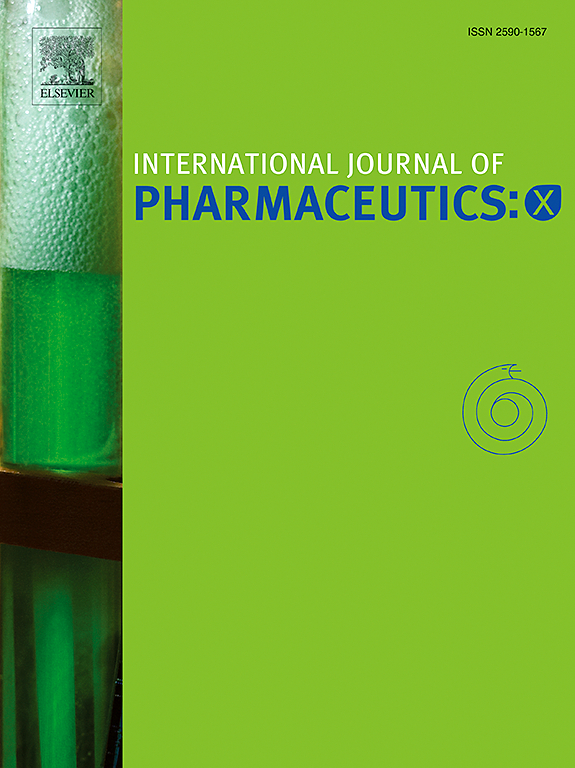Enrofloxacin‑silver composite nano-emulsion as a scalable synergetic antibacterial platform for accelerating infected wound healing
IF 6.4
2区 医学
Q1 PHARMACOLOGY & PHARMACY
引用次数: 0
Abstract
The colonization of bacterial pathogens is a major concern in wound infection and becoming a notable medical issue. Enrofloxacin (ENR) can be applied to treat skin infections, while poor water solubility and bioavailability limit its clinical application. Nanostructured lipid carriers (NLCs) enhance the solubility and bioavailability of drugs by encapsulating them, making them effective for the topical treatment of skin wound infections. Additionally, to enhance treatment efficacy and further improve wound healing, silver nanoparticles (AgNPs) were attached to the aforementioned matrix, which also improved its colloidal stability and reduced toxicity. Herein, a scalable poly (vinyl alcohol) modified NLCs-based antibacterial platform was fabricated by high-pressure homogenization method, to co-load ENR and AgNPs for treating the bacterial-infected wounds. The growth of common wound bacterial pathogens (Escherichia coli, Staphylococcus aureus and Pseudomonas aeruginosa) was synergistically inhibited by released ENR and Ag+ from the poly (vinyl alcohol) modified enrofloxacin‑silver composite nano-emulsion (ENR@PVA-NLCs/AgNPs). In the in vivo wound model, the Staphylococcus aureus-infected wound in rat almost completely disappeared after treatment with ENR@PVA-NLCs/AgNPs, and no suppuration symptom was observed. Importantly, this nanoplatform had negligible side effects in vivo. Taken together, the above results strongly demonstrate the promising potential of ENR@PVA-NLCs/AgNPs as a synergistic therapeutic agent for clinical wound infections.

恩诺沙星-银复合纳米乳剂作为加速感染伤口愈合的可扩展协同抗菌平台
细菌病原体的定植是伤口感染的一个主要问题,并成为一个值得注意的医学问题。恩诺沙星(ENR)可用于治疗皮肤感染,但其水溶性和生物利用度较差,限制了其临床应用。纳米结构脂质载体(nlc)通过包裹药物来提高药物的溶解度和生物利用度,使其有效地用于皮肤伤口感染的局部治疗。此外,为了提高治疗效果,进一步改善伤口愈合,将银纳米粒子(AgNPs)附着在上述基质上,也提高了其胶体稳定性,降低了毒性。本研究采用高压均质法制备了可伸缩的聚乙烯醇修饰的nlc抗菌平台,将ENR和AgNPs共载于细菌感染的伤口。聚乙烯醇修饰恩诺沙星-银复合纳米乳剂(ENR@PVA-NLCs/AgNPs)释放的ENR和Ag+能协同抑制常见创面细菌病原菌(大肠杆菌、金黄色葡萄球菌和铜绿假单胞菌)的生长。在体内创面模型中,ENR@PVA-NLCs/AgNPs处理后,金黄色葡萄球菌感染的大鼠创面几乎完全消失,未见化脓症状。重要的是,这种纳米平台在体内的副作用可以忽略不计。综上所述,上述结果有力地证明了ENR@PVA-NLCs/AgNPs作为临床伤口感染的协同治疗剂的巨大潜力。
本文章由计算机程序翻译,如有差异,请以英文原文为准。
求助全文
约1分钟内获得全文
求助全文
来源期刊

International Journal of Pharmaceutics: X
Pharmacology, Toxicology and Pharmaceutics-Pharmaceutical Science
CiteScore
6.60
自引率
0.00%
发文量
32
审稿时长
24 days
期刊介绍:
International Journal of Pharmaceutics: X offers authors with high-quality research who want to publish in a gold open access journal the opportunity to make their work immediately, permanently, and freely accessible.
International Journal of Pharmaceutics: X authors will pay an article publishing charge (APC), have a choice of license options, and retain copyright. Please check the APC here. The journal is indexed in SCOPUS, PUBMED, PMC and DOAJ.
The International Journal of Pharmaceutics is the second most cited journal in the "Pharmacy & Pharmacology" category out of 358 journals, being the true home for pharmaceutical scientists concerned with the physical, chemical and biological properties of devices and delivery systems for drugs, vaccines and biologicals, including their design, manufacture and evaluation. This includes evaluation of the properties of drugs, excipients such as surfactants and polymers and novel materials. The journal has special sections on pharmaceutical nanotechnology and personalized medicines, and publishes research papers, reviews, commentaries and letters to the editor as well as special issues.
 求助内容:
求助内容: 应助结果提醒方式:
应助结果提醒方式:


